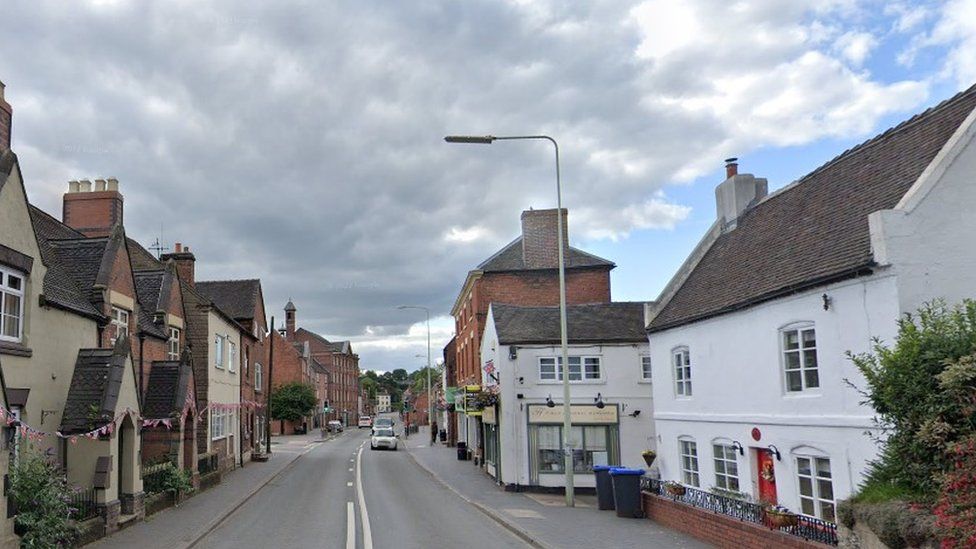
Residents reported "rumbling" and rattling windows and doors after a 3.3 magnitude earthquake hit Staffordshire on Wednesday evening.
The British Geological Survey (BGS) said the tremor's epicentre was 7.3km (4.5 miles) below Tean.
People as far away as Yorkshire took to social media to describe the effects.
The BGS said people had reported "an initial rumbling, then a bang" with what "felt more like a shunt, like something had hit something".
It is the largest of 21 earthquakes to strike the UK in the past two months.
Allow Twitter content?
This article contains content provided by Twitter. We ask for your permission before anything is loaded, as they may be using cookies and other technologies. You may want to read Twitter’s cookie policy and privacy policy before accepting. To view this content choose ‘accept and continue’.
Kelvin Evans, in Upper Tean, said he heard a "very loud, weird, spooky noise, that seemed to vibrate the front of the house."
Another Tean resident, Jenni Brown, said she thought a vehicle had veered off the road and bumped the side of her house.
'A very large shake'
Carol Heather, from Hilderstone, said she felt an impact and noise so loud she thought it was a bomb.
"My hair stood on end, I was jolted out of my seat. I was just watching a film and it was really frightening, terrifying. It was such a bang."
Mark Begg, 30, said he was at home in Uttoxeter when he felt "a very large shake".
After checking the house and finding no signs of damage he concluded "it was most likely a mini-earthquake".
Tom, 38, in Cheadle said: "I was sitting watching an episode of Only Connect with my wife on YouTube and as we opened another bottle of wine the whole house shook.
"I thought either one of the children had fallen out of bed or something else had happened."
Several people in Derbyshire also reported feeling the quake which included Gurj Sanghera who tweeted to ask if anyone else felt it in Derby while Andy Savage posted "there was deffo something it was brief".
Allow Twitter content?
This article contains content provided by Twitter. We ask for your permission before anything is loaded, as they may be using cookies and other technologies. You may want to read Twitter’s cookie policy and privacy policy before accepting. To view this content choose ‘accept and continue’.
In Sheffield, 67km (42 miles) from the epicentre, people tweeted they had felt the tremor clearly in High Storrs, with a "slight rumble" in the Ranmoor area.
Dr Ian Stimpson, a senior lecturer in geophysics at Keele University, said the area had not historically been hit by earth tremors.
"With this location and depth it is likely to be a natural earthquake rather than anything to do with former mines," he added.
David Hawthorn, a seismologist from the BGS, agreed the quake was unlikely to have been caused by disused mine shafts.
"We think it was about 7-8 km (4.3-4.9 miles) deep and that would be very deep for old mine workings," he said.
The quake was "reasonably big" in a UK context, he added, but about 39,000 times less powerful that the deadly earthquake that hit Turkey in February.
An aftershock could not be ruled out, he said, but was likely to be smaller.
The BGS records and locates between 200 and 300 earthquakes in the UK each year with the majority only detected by sensitive instruments.
The largest earthquake ever recorded in the UK was in the North Sea on 7 June 1931, with a magnitude of 6.1.
The epicentre was in the Dogger Bank area, 75 miles (120km) north-east of Great Yarmouth, Norfolk.
What causes an earthquake?
The Earth's surface is made up of huge pieces of flat rock called tectonic plates.
They float on top of a layer of softer rock called the mantle.
Tectonic plates move very slowly, over millions of years, and where they come together is called a fault.
When the plates rub together, friction forces waves of energy to come to the surface.
This causes tremors and shakes - and these are called earthquakes.
Earthquakes can happen anywhere there is a fault or weakness in the crust, however, major earthquakes usually only occur at plate boundaries.
This video can not be played
To play this video you need to enable JavaScript in your browser.

Follow BBC West Midlands on Facebook, Twitter and Instagram. Send your story ideas to: newsonline.westmidlands@bbc.co.uk
Related Topics
Related Internet Links
https://news.google.com/rss/articles/CBMiQGh0dHBzOi8vd3d3LmJiYy5jb20vbmV3cy91ay1lbmdsYW5kLXN0b2tlLXN0YWZmb3Jkc2hpcmUtNjYwNTA1OTjSAURodHRwczovL3d3dy5iYmMuY29tL25ld3MvdWstZW5nbGFuZC1zdG9rZS1zdGFmZm9yZHNoaXJlLTY2MDUwNTk4LmFtcA?oc=5
2023-06-29 06:46:01Z
CBMiQGh0dHBzOi8vd3d3LmJiYy5jb20vbmV3cy91ay1lbmdsYW5kLXN0b2tlLXN0YWZmb3Jkc2hpcmUtNjYwNTA1OTjSAURodHRwczovL3d3dy5iYmMuY29tL25ld3MvdWstZW5nbGFuZC1zdG9rZS1zdGFmZm9yZHNoaXJlLTY2MDUwNTk4LmFtcA
Tidak ada komentar:
Posting Komentar